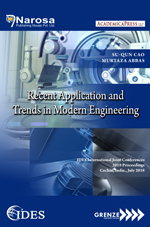Performance Comparison of Hyperspectral Oil Spill Detection Algorithms using Hybrid Similarity Measures
Conference: Recent Application and Trends in Modern Engineering
AbstractHyperspectral remote sensing technology and the subsequent image\nanalysis, works by exploiting the optical property of the material under\nconsideration. The hyperspectral algorithms are readily used in various\napplications like species level mapping, NDVI and mineral classifications. The\nmarine environment is a composite system, where a multitude of factors\ndetermine the water quality levels. Degradation in water quality due to factors\nlike oil spill can be reduced, if they are assessed efficiently. In practice, oil spills\nin marine environment shows complex spectral behaviour owing to many\nbackground interferences making constraints on the effectiveness of\nhyperspectral methods. Spectral matching approaches are developed to extract\nincreased level of details from hyperspectral data. Conversely, little emphasis has\nbeen given to check the effectiveness of the various spectral matching algorithms\nfor oil spill mapping. In this study, the performance of hybrid similarity measures\non EO-1 Hyperion image for oil spill is investigated to overcome the problem of overestimation produced in non-hybrid methods. The appropriate similarity\nmeasure and suitable reference spectra for further scrutiny is selected based on\nthe spectral discriminatory measures like Relative Spectral Discriminatory\nProbability (RSDPB), Relative Spectral discriminatory Power (RSDPW) and\nRelative Spectral Discriminatory Entropy (RSDE). The results collectively\nrevealed that among the chosen algorithms, SIDSCM is identified as the most\nreliable hybrid similarity measure for oil spill identification from hyperspectral\ndata. |
RATME - 2018
|
